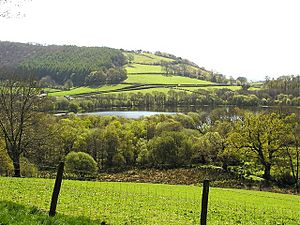Talley Lakes facts for kids
Upper Talley Lake and Lower Talley Lake are two lovely lakes in Wales. They are found just north of a village called Talley. This is about 7 miles (11 km) north of Llandeilo in Carmarthenshire. In Welsh, they are called Llyn Talyllychau Uchaf and Llyn Talyllychau Isaf. These lakes are very special. They are protected as a Site of Special Scientific Interest (SSSI). This means they are important for their nature.
Contents
How the Lakes Were Formed
These two lakes sit in a hollow. This hollow was carved out by a glacier during the last ice age. Imagine a giant scoop of ice digging out the land! The land between the lakes is bumpy. It is made of rocks and dirt left behind by the glacier. Lower Talley Lake is about 16 acres (6.5 hectares) big. Upper Talley Lake is larger, at about 27 acres (11 hectares). The whole protected area, the SSSI, covers about 25 hectares (62 acres).
A Look Back in Time: History of the Lakes
There's a cool piece of history between the two lakes. You can still see the remains of an old Norman castle there. It was a "motte-and-bailey" castle. This means it had a big mound (the motte) and a fenced area (the bailey). The castle mound is about 30 meters (98 feet) wide. It stands about 4 meters (13 feet) high. A wooden tower would have sat on top of this mound. The bailey area would have held the lord's house and other buildings. This castle was probably not used anymore once Talley Abbey was built nearby.
Talley Abbey is just south of the upper lake. It was started a long, long time ago, between 1184 and 1189. The monks who lived there used the lakes. They would farm fish in the water for food. The abbey was later closed down in the 1500s. Now, it is a ruin, but you can still visit it.
Mysteries and Legends: Mythology
There's an old story about these lakes. Some people believe that a whole town lies hidden beneath the water. It's said to have been drowned long ago.
Wildlife and Nature Around the Lakes
The lower lake is quite hidden. It is surrounded by alder and willow trees. It's a quiet spot that is hard to reach. Many wild birds come here to spend the winter. The upper lake is more open. You can see it easily from the B4302 road.
Birds of Talley Lakes
Many interesting birds live or visit these lakes.
- Great crested grebes are often seen. They are known for their fancy head feathers.
- Mute swans also breed here regularly.
- Other birds that visit include tufted ducks.
- You might also spot pochards and goldeneye ducks.
- Goosanders are another regular visitor.
Plants of Talley Lakes
The lower lake has some beautiful water plants.
- You can see bright yellow and white water lilies.
- There's also a plant called water crowfoot.
- The water sedge grows here too. This is the most southerly place in Britain where this plant is found.
Insects and Other Creatures
The reserve is home to many small creatures.
- You can find different kinds of water beetles.
- A special leaf beetle called Donacia obscura lives here.
- Dragonflies are very common. You might see the large and colorful emperor dragonfly.


